This is the main page for up-to-date resources and information on the federal response to Hurricane Maria.
Follow the direction of state, local, and tribal officials. (Español)

News
Puerto Rico News Releases
FollowUs
@FEMAPuertoRico
Recovery Updates
Subscribe to receive Puerto Rico Recovery Updates
Follow Us
@FEMAUSVirginIslands
One Year After Hurricane María
“We’ll be here until the job is complete.”
--Federal Coordinating Officer Michael Byrne
One year after hurricanes Irma and María devastated Puerto Rico, FEMA, its federal partners and the Government of Puerto Rico are undertaking one of the largest post-disaster reconstruction and humanitarian efforts in U.S. history.
Major portions of the infrastructure are being rebuilt as federal agencies support the Government of Puerto Rico’s plan to restore the island’s lifeline systems and enable Puerto Rico to withstand the storms to come.
In 2017, Hurricanes Irma, María and other disasters affected nearly 47 million people in the United States. While recovery continues, FEMA and its interagency partners remain focused and dedicated to the continued stabilization and resilience of impacted communities. FEMA continues to support response and recovery from hurricanes Harvey, Irma, María and the California wildfires.
After Hurricane Maria, Puerto Rico had no electricity, no water, no telecommunications and no transportation systems. Today, electricity is flowing, water systems are operating, traffic is moving, airports and seaports are operating and permanent reconstruction has already begun.
Never before has FEMA coordinated federal resources to rebuild an entire commonwealth with a population of 3.3 million people, 78 municipalities, electrical, water and telecommunications systems, seaports, airports, schools, healthcare system, roads and bridges. More than 166,000 homes need repair or reconstruction.
Unique Challenges
The response to Hurricane María was unprecedented. It was the largest and longest federal response to a domestic disaster in the history of the United States. To put María’s impacts into context, this has been:
- The longest sustained domestic air mission of food and water response in U.S. history;
- The largest disaster commodity distribution mission in U.S. history;
- The largest sea-bridge operation of federal disaster aid in U.S. history;
- The largest disaster generator installation mission in the United States, with generators still installed at critical facilities today;
- One of the largest disaster medical response missions in U.S. history; and
- One of largest disaster housing missions in U.S. history.
Then and Now
After María, Puerto Rico’s entire electrical grid failed. Nobody had power. In 30 days, 21 percent of customers were restored to power; in 60 days, 49 percent; in 90 days, 65 percent. Today, power has been restored to 99.99 percent of customers able to receive an electrical hookup.
Water systems were inoperable. Water service went from 20 to 69 percent operational in 30 days, 91 percent in 60 days. Today, 99.5 percent of water customers are restored.
Debris from María and 41,000 landslides shut down all but 400 miles of Puerto Rico’s 16,700 miles of roads, cutting off municipalities across the island. Today, the roads are clear and traffic is moving.
María knocked out 95 percent of cellular sites. In 30 days, 61 percent of cellular sites were operating; in 60 days, 96 percent; today, 99.8 percent.
“This is a massive job and it has taken a massive effort by everybody: the Government of Puerto and the municipalities, federal agencies, voluntary and faith-based organizations and the private sector,” said Federal Coordinating Officer Michael Byrne, who is leading FEMA’s recovery efforts. “This work will go on for years, and we’ll be here until the job is complete.”
Progress in neighborhoods, restoration of services

More than 462,000 households have received a total of $1.4 billion in FEMA Individual Assistance for essential home repairs, rental assistance and other disaster-related costs. Under FEMA’s Temporary Sheltering Assistance program more than 7,000 families were housed in just over 1,000 hotels in 41 states, the District of Columbia and Puerto Rico.
To date, the Tu Hogar Renace (Your Home Reborn) program, administered by the Government of Puerto Rico and funded by FEMA, repaired 68,654 homes. Voluntary Agencies Leading and Organizing Repair, VALOR, repaired 1,403 homes.
The U.S. Small Business Administration approved $1.8 billion in low-interest disaster loans to 52,228 homeowners, renters and businesses. The National Flood Insurance Program paid $21 million to policyholders.
Eight million cubic yards of debris was removed by the U.S. Army Corps of Engineers and local jurisdictions. USACE installed emergency generators at 1,300 sites to support critical facilities. USACE also installed 59,469 blue roofs and FEMA supplied 126,000 blue tarps for homeowners to install.
The U.S. Department of Housing and Urban Development awarded the Government of Puerto Rico $20 billion in Community Development Block Grants to help rebuild housing and meet other community needs.
FEMA has obligated more than $3.3 billion in Public Assistance grants to help pay for debris removal, power restoration and emergency services; more funding is planned for repair or replacement of public infrastructure.
Preparations for the next storm
Puerto Rico’s Central Office of Recovery, Reconstruction and Resiliency reports that 74 of the island’s 78 municipalities have selected recovery projects to help build future resiliency, with the support and guidance of FEMA incident management assistance teams. Puerto Rico’s Emergency Operations Center practiced responding to simulated incidents with support from FEMA personnel. Training also has been provided to personnel involved in health care, energy, water, telecommunications, transportation, debris removal and commodity distribution.
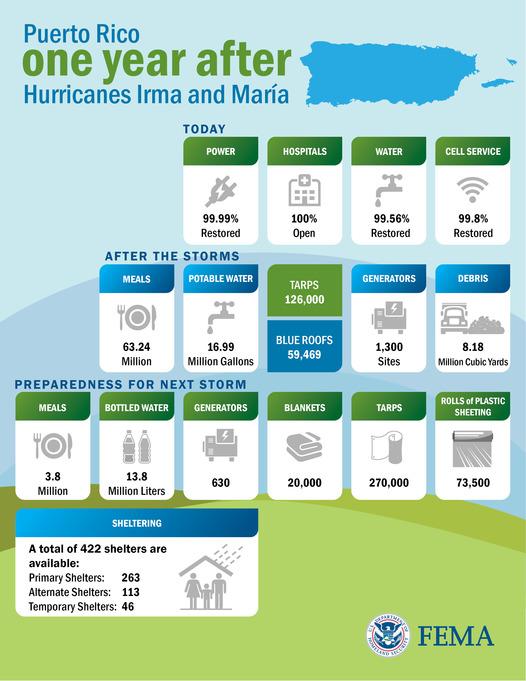
Currently 422 shelters are available if needed. FEMA has increased the amount of commodities stored on the island in four new warehouses:
- 13.8 million liters of water
- 3.8 million meals
- 630 generators
- 20,000 blankets
- 270,000 tarps
- 73,500 rolls of plastic sheeting
The devastating hurricanes and wildfires of 2017 reminded the nation of the importance of preparing for disasters. It is important for residents to prepare in advance to help themselves and their community. Find tips at Disasters Happen. Prepare Now. Learn How.
Federal Recovery Updates
All figures as of December 14, 2018
We update these figures weekly, Monday through Friday; for the most current progress of recovery related to a number of critical sectors in Puerto Rico, please visit the Government of Puerto Rico's website: www.status.pr
By the Numbers
Amounts of assistance provided by FEMA to survivors and communities in Puerto Rico following Hurricane Maria.
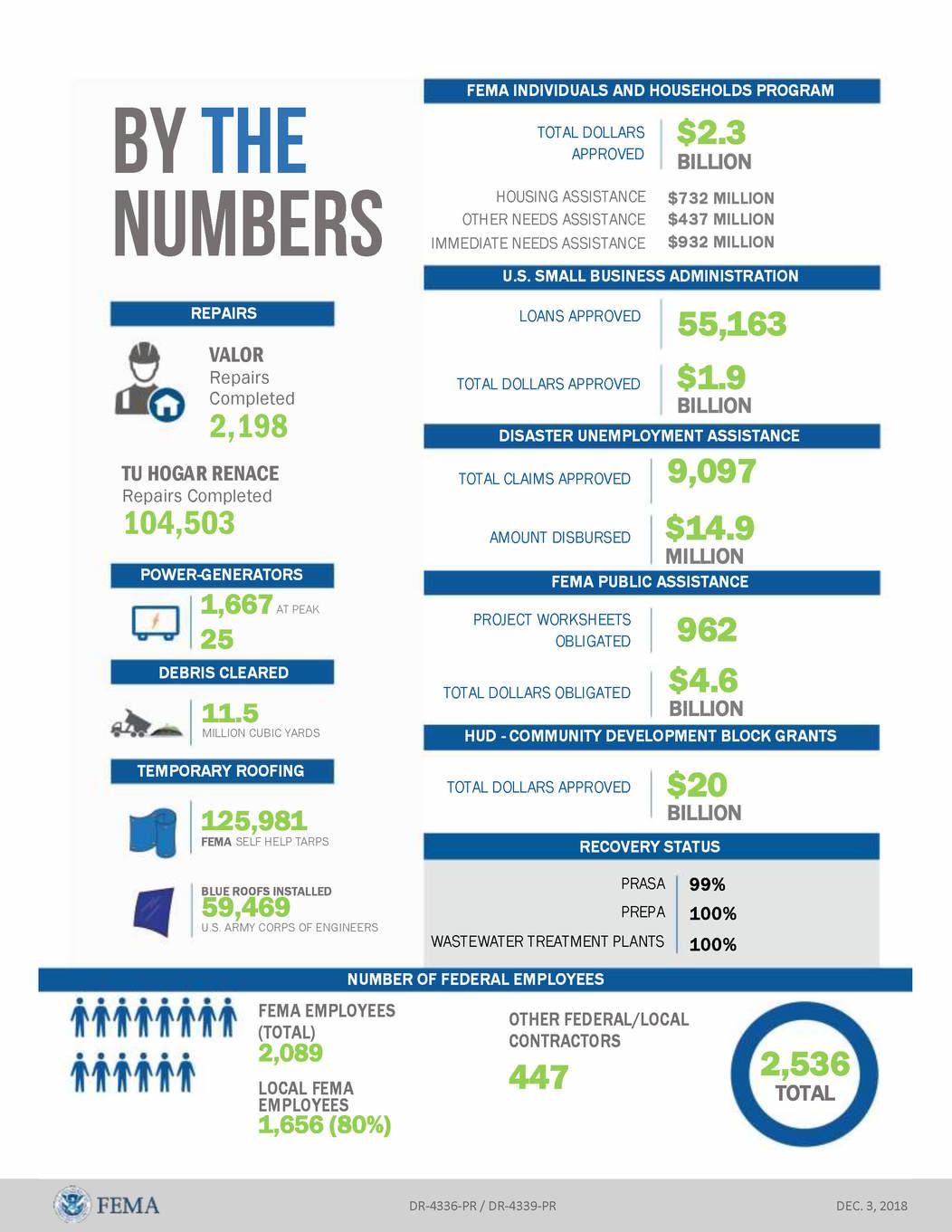
Repairs
- VALOR repairs completed: 2,166
- Tu Hogar Renace repairs completed: 103,238
Power Generators
- Active: 35
- At Peak: 1,667
Debris Cleared
- 11.5 million cubic yards
Temporary Roofing
- FEMA Self Help Tarps: 125,981
- Blue Roofs installed: 59,469 (U.S. Army Corps of Engineers)
FEMA Individuals and Households Program
Total dollars approved: $2.3 billion
- Housing Assistance: $732 million
- Other Needs Assistance: $436 million
- Immediate Needs Assistance: $930 million
U.S. Small Business Administration (SBA)
- Loans approved: 54,796
- Total dollars approved: $1.9 billion
Disaster Unemployment Assistance
- Total claims approved: 9,097
- Amount disbursed: $14.9 million
FEMA Public Assistance
- Project worksheets obligated: 918
- Total dollars obligated: $4.2 billion
HUD Community Development Block Grants
- Total dollars approved: $20 billion
Recovery Status
- PRASA 99.41%
- PREPA 99.99%
- Wastewater Treatment Plants 100%
Puerto Rico Rebuilding
Summary of federal assistance provided to help Puerto Rico respond to and recover from Hurricane Maria.

- Public Assitance - $4.2 billion total approved
- $586 million funding for Debris Removal
- $3.1 billion funding for Emergency Protective Measures
- $1.9 billion Puerto Rico Electric Power Authority
- Hazard Mitigation Grant Program - $8.5 million obligated
- Community Disaster Loans - $292 million total approved
- Number of Municipalities - 74
- USACE Mission Assignments - $3.6 billion
- Grid Restoration - $2.1 billion
- Temporary Power Generators - $823 million
- Generator Maintenance to Critical Infrastructure - $89 million
- Debris Removal Mission Assignments - $216 million
- HUD Community Development Disaster Recovery - $20 billion awarded
- Department of Education - nearly $600 million (as of May 29, 2018)
Federal Housing Snapshot
A snapshot of federal housing assistance provided to Hurricane Maria survivors in Puerto Rico.
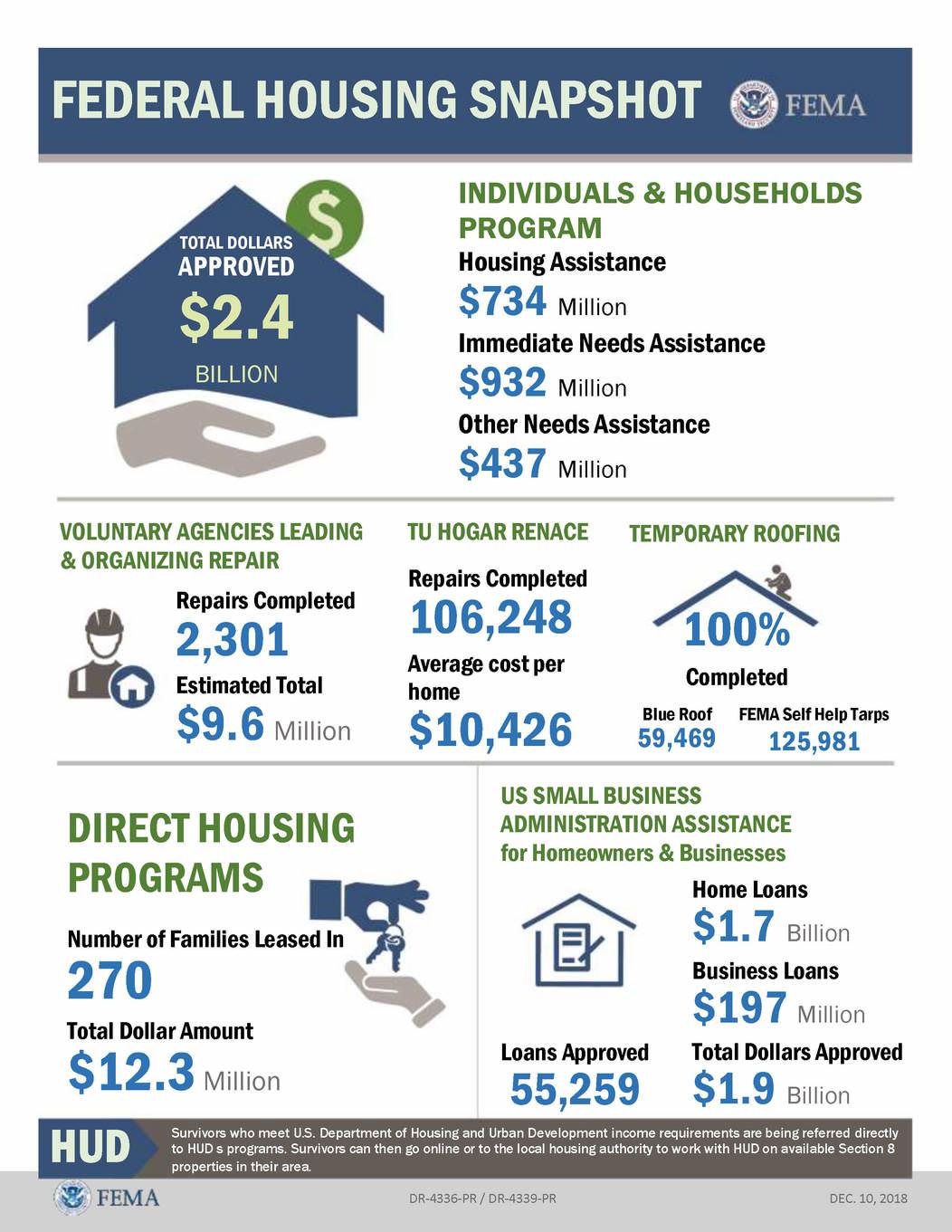
Individual & Households Program
Total dollars approved - $2.4 billion
- Housing Assistance - $734 million
- Immediate Needs Assistance - $932 million
- Other Needs Assistance - $431 million
Voluntary Agencies Leading and Organizing Repair
Repairs completed - 2,301
- Estimated total - $9.6 million
Tu Hogar Renace
Repairs completed - 106,248
- Average cost per home - $10,426
Temporary Roofing
100% completed
- Blue Roof - 59,469
- FEMA Self Help Tarps - 125, 981
Direct Housing Programs
290 families leased in.
- Total dollar amount - $12.3 million
U.S. Small Business Administration Assistance for Homeowners & Businesses
Loans approved - 55,259
- Home Loans - $1.7 billion
- Business Loans - $197 million
- Total dollars approved - $1.9 billion
Commodity Distribution
FEMA’s inventory of commodities in Puerto Rico for the 2018 Hurricane Season as of November 8, 2018.
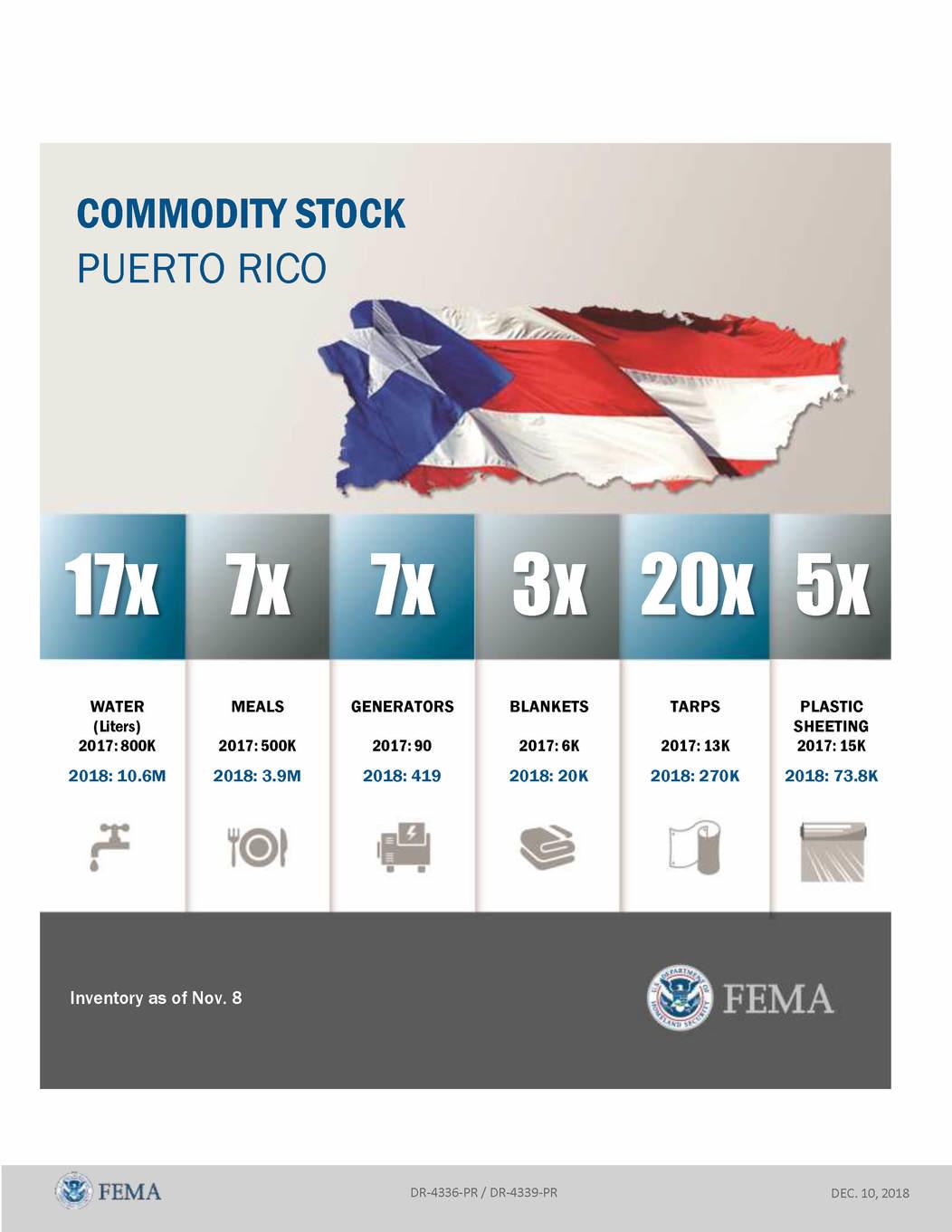
FEMA, working in coordination with federal partners, provided more than 63.24 million meals and 74.88 million liters of water to Puerto Rico and U.S. Virgin Islands, as of July 30, 2018.
To see more photos of the federal response to Hurricane Maria, visit the following collections from our federal partners:
Construction Techniques to Minimize Damage
FEMA has prepared six Recovery Advisories in English and Spanish to describe mitigation measures that can be taken to minimize building damage.
A Mitigation Assessment Team was deployed to Puerto Rico in response to Hurricane Maria to evaluate the performance of buildings and infrastructure. Recovery Advisories are based on these field observations and provide information to assist with rebuilding decisions in the aftermath of the 2017 hurricanes as well as any future floodingor high wind events. This guidance is intended for homeowners, designers, building owners and officials, architects, engineers, and contractors; however, can provide helpful information for other stakeholders as well.
For more information visit the following links:
U.S. Virgin Islands
Installation of Residential Corrugated Metal Roof Systems
Design Installation and Retrofit of Doors Windows and Shutters
Rooftop Solar Panel Attachment: Design, Installation, and Maintenance
Puerto Rico
Rooftop Equipment Maintenance and Attachment in High-Wind Regions
Safe Rooms and Storm Shelters for Life-Safety Protection from Hurricanes
Best Practices for Minimizing Flood Damage to Existing Structures
Repair and Replacement of Wood Residential Roof Covering System
Emergency Preparedness
Regardless of when they form and the geographic location they hit, hurricanes leave a path of destruction for everyone to repair. In situations like these, the only thing we can do is make sure we prepare for the hurricane before it arrives.
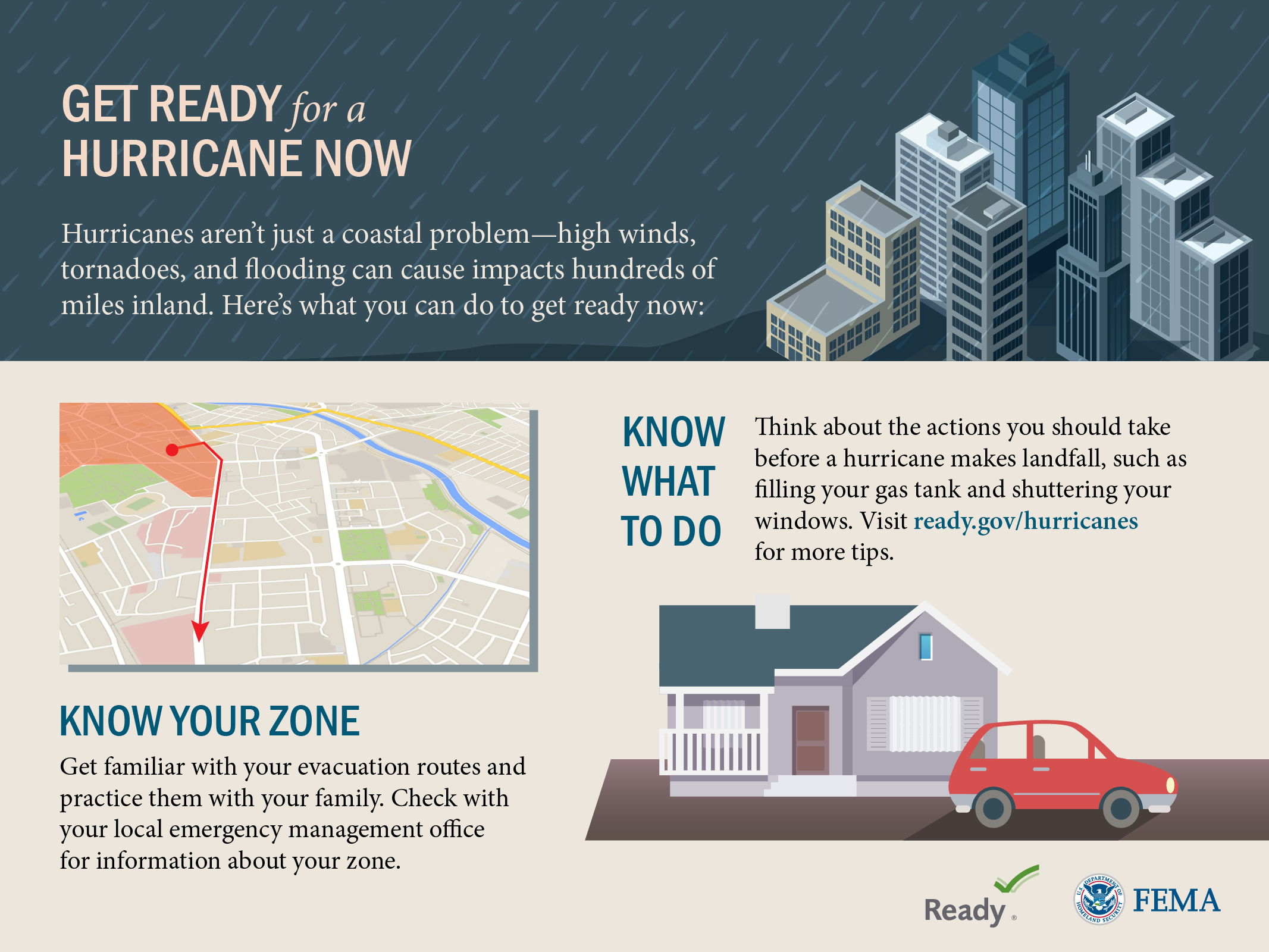
Evacuation Tips

Helping Children Cope
To talk to a professional who can help you cope with emotional distress from the storm: Call the @disasterdistressline at (800) 985-5990 crisis support services are available 24/7.
Children may cope more effectively with a disaster when they feel they understand what is happening and what they can do to help protect themselves, their family, and friends. Here’s how you can help them cope and a Fact Sheet:
- Talk about the concerns about the storm with your children. To not talk about it makes it even more threatening in your children's mind. Start by asking what your children have already heard and what understanding they have. As your children explain, listen for misinformation, misconceptions, and underlying fears or concerns, and then address these.
- Explain - as simply and directly as possible - what is happening or likely to happen. The amount of information that will be helpful to children depends on their age and developmental level, as well as their coping style. For example, older children generally want and will benefit from more detailed information than younger children. Because every child is different, take cues from your own children as to how much information to provide.
- Encourage your children to ask questions, and answer those questions directly. Like adults, children are better able to cope with a crisis if they feel they understand it. Question-and-answer exchanges help to ensure ongoing support as your children begin to understand the crisis and the response to it.
- Limit television viewing of disasters and other crisis events, especially for younger children. Consider coverage on all media, including the internet and social media. When older children watch television, try to watch with them and use the opportunity to discuss what is being seen and how it makes you and your children feel.
- Reassure children of the steps that are being taken to keep them safe. Disasters and other crises remind us that we are never completely safe from harm. Now more than ever it is important to reassure children that, in reality, they should feel safe in their schools, homes, and communities.
- Consider sharing your feelings about a crisis with your children. This is an opportunity for you to role model how to cope and how to plan for the future. Before you reach out, however, be sure that you are able to express a positive or hopeful plan.
- Help your children to identify concrete actions they can take to help those affected by recent events. Rather than focus on what could have been done to prevent a disaster or other crisis, concentrate on what can be done now to help those affected by the event.
- Play games and do activities together to create meaningful dialogue and offer a distraction.
- If you have concerns about your children's behavior, contact your children's pediatrician, other primary care provider, or a qualified mental health professional.
Disaster Fraud & Price Gouging
After a disaster scam artists, identity thieves and other criminals may attempt to prey on vulnerable survivors. The most common post-disaster fraud practices include phony housing inspectors, fraudulent building contractors, bogus pleas for disaster donations and fake offers of state or federal aid.
- If you have any concerns about individuals representing themselves as FEMA or would like to report fraud, please contact the National Center for Disaster Fraud at (866) 720-5721 or via email at disaster@leo.gov.
Dealing with Contractors:
Survivors should take steps to protect themselves and avoid fraud when hiring contractors to clean property, remove debris or make repairs.
Simple rules to avoid becoming a victim of fraud:
- Only use contractors licensed by your state
- Get a written estimate and get more than one estimate
- Demand and check references
- Ask for proof of insurance
- i.e., liability and Workmen's Compensation
- Insist on a written contract and refuse to sign a contract with blank spaces
- Get any guarantees in writing
- Make final payments only after the work is completed
- Pay by check.
The best way to avoid fraud is to arm yourself against it by having a checklist to remind you of what you need to demand when hiring a contractor.
Contact Us
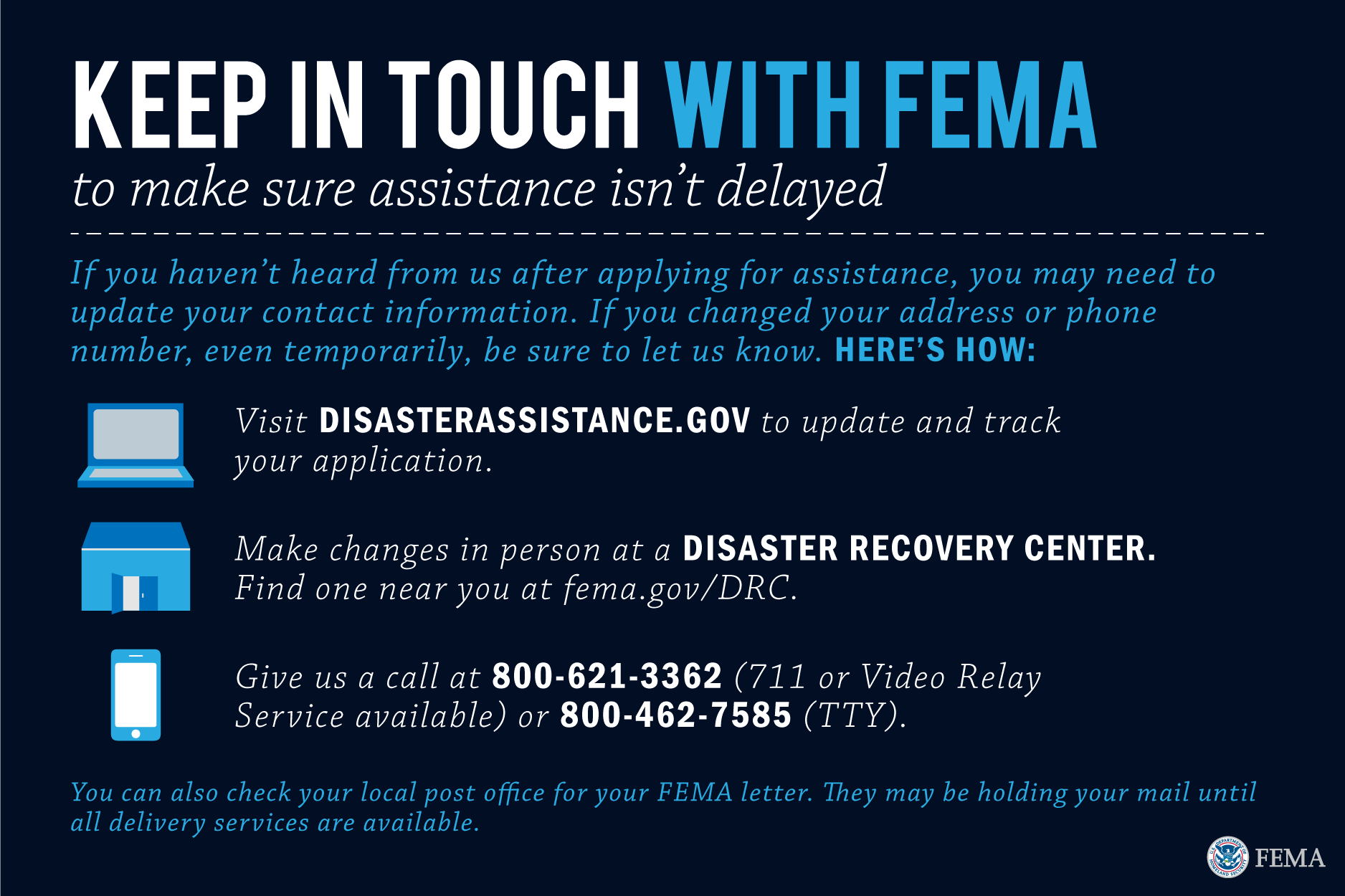
If you haven’t heard from us after applying for assistance, you may need to update your contact information. If you changed your address or phone, even temporarily, be sure to let us know. Here is how:
- Visit https://www.disasterassistance.gov/ to update and track your application.
- Make changes in person at a Community Recovery Center.
- Make sure you have your nine-digit FEMA registration number at all times.
FEMA Helpline
Contact the FEMA Helpline if you have questions about:
- The help offered by FEMA.
- How to apply for assistance.
- Information in your account.
Call 7 a.m. to 11 p.m.ET, 7 days a week:
- 1-800-621-FEMA (1-800-621-3362) (711 or Video Relay Service available)
- TTY 1-800-462-7585
Or write to:
FEMA
P.O. Box 10055
Hyattsville, MD 20782-8055
Media Contacts
For media inquiries in Puerto Rico, callFEMA Puerto Rico News Desk at (866) 366-8807.
For other inquiries,visit FEMA's Media Contacts or call 202-646-3272.
